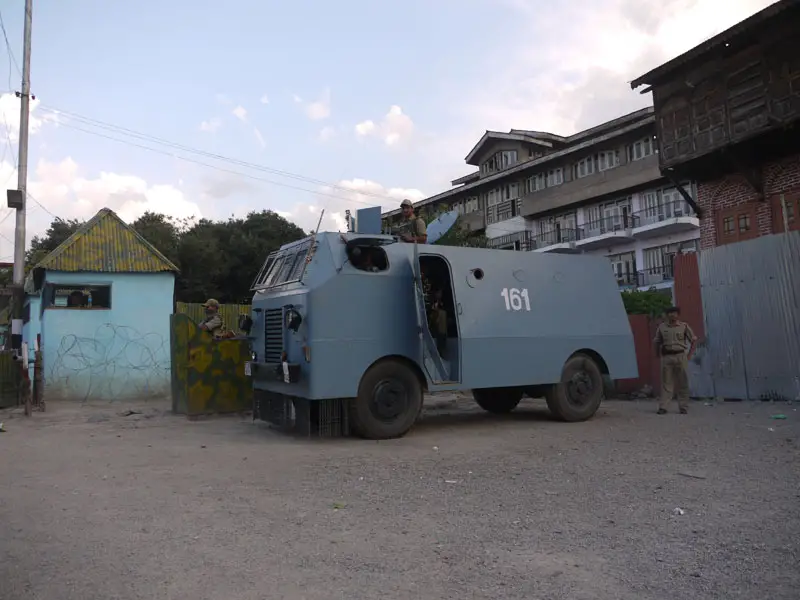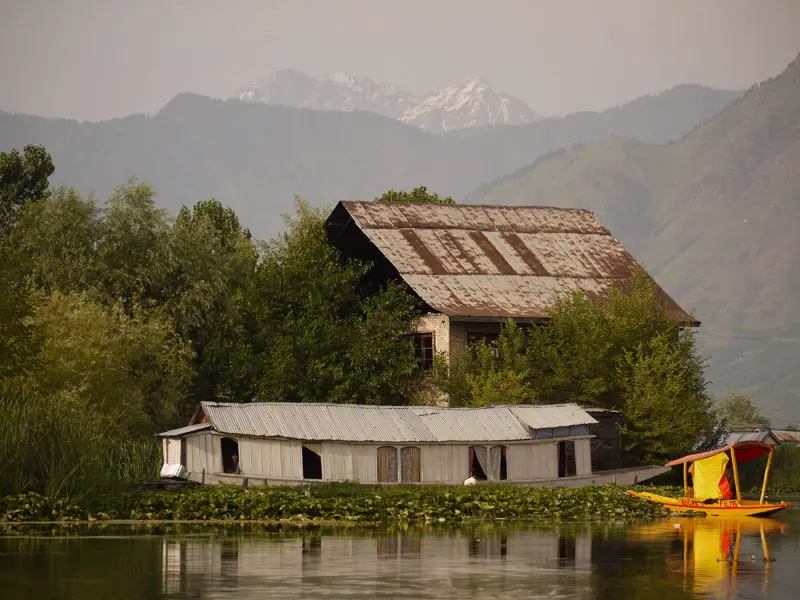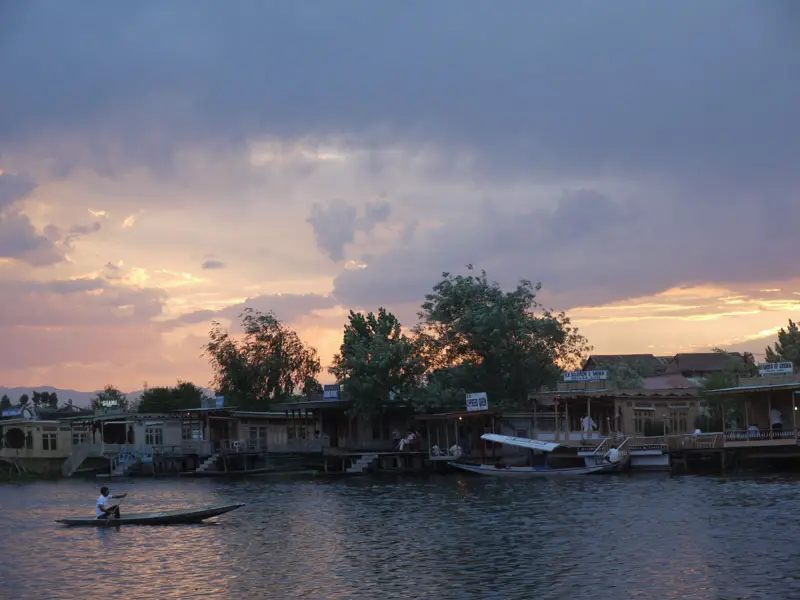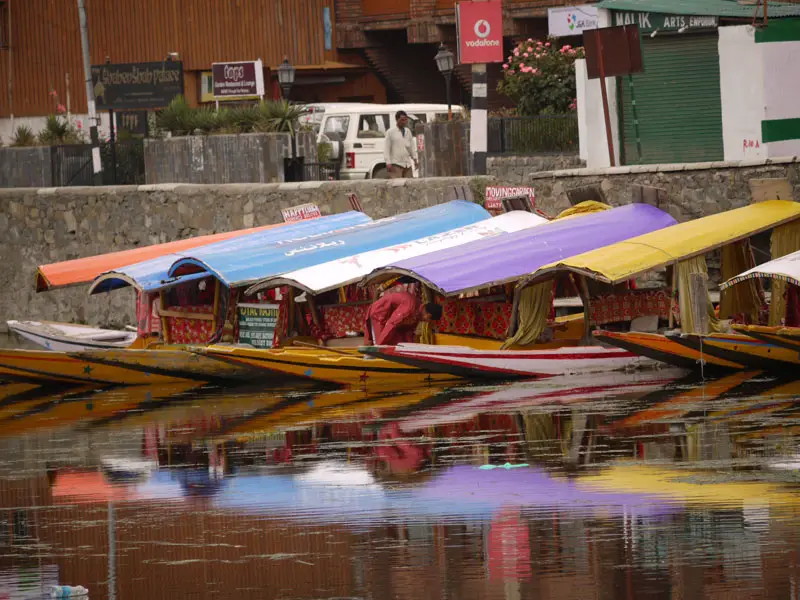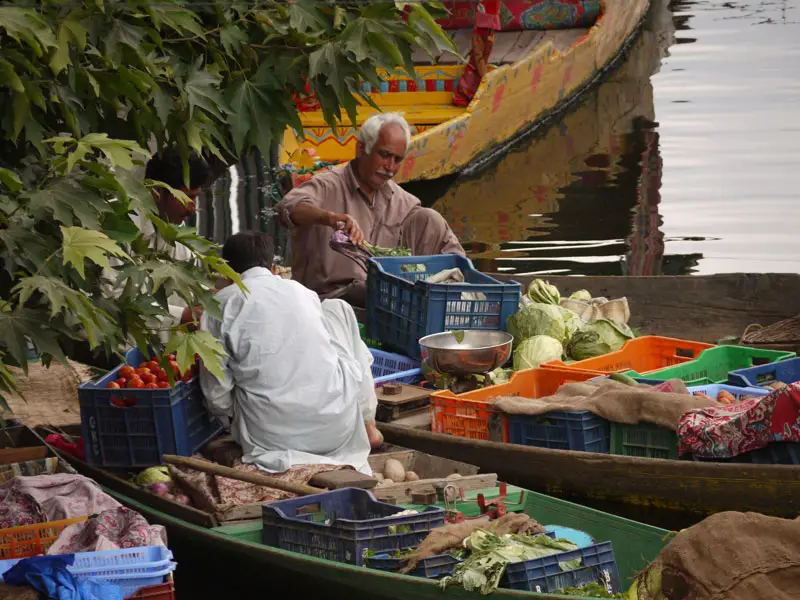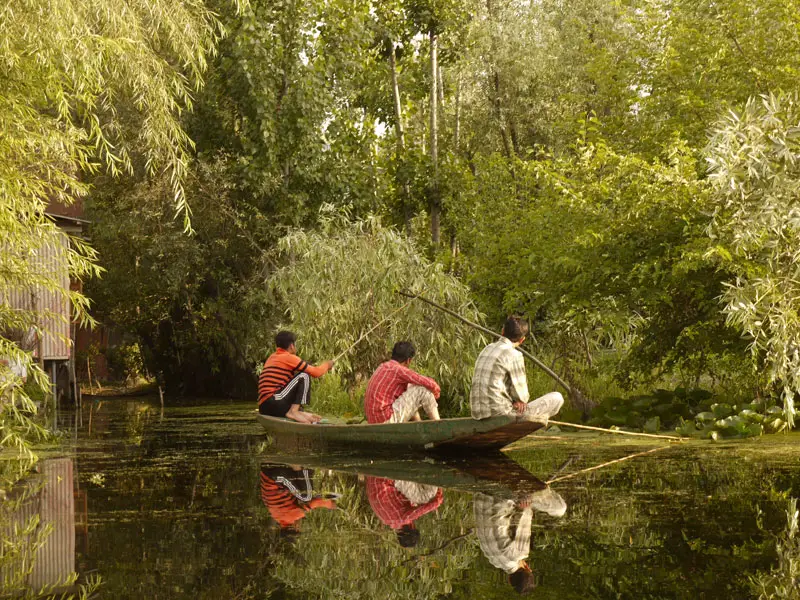Leaving the barren, rugged mountain desert of Ladakh behind us, we drove west through the night to the capital of Kashmir, the lakeside city of Srinagar. Fifteen hours and five hundred kilometers later the enormous Dal Lake Srinagar appeared on our left. Driving slowly into the city the driver pointed out the famous Mughal Gardens, Shankaracharya Hill and in the distance the eye-catching Hari Parbat Fort. However, immediately after arriving in Srinagar we were distracted from the drive by tour by the heavy military presence which lined the roadside at the banks of Dal lake. Small groups of armed soldiers were standing beneath the shade of the trees. Dressed in khaki uniforms and navy beret-style hats, the soldiers carried a variety of weapons between them including rifles, shotguns and machine guns and while they were smiling now, I wouldn’t fancy crossing them.
Kashmir has long been a delicate political issue in Central Asia. India and Pakistan have been fighting over the state of Kashmir since 1947. Even though the majority of Kashmir’s population are Muslim, the then leader favoured joining India. Many Kashmiri’s wanted an independent state but were indecisive in their decision-making and so Pakistan made a move to try take control of the state by force and had almost claimed the city of Srinagar when, just in time India intervened and pushed the Pakistani troops back out of the Kashmir Valley. Pakistan retained power in Baltiistan, Muzaffarabad and also controlled the valley’s main access route. Kashmir has remained divided since and was the cause of a further Pakistani invasion in 1965. Pro-Pakistani Islamic extremists launched an armed rebellion in 1990, beginning years of unrest in the region, during which time bomb attacks and massacres were countered by Indian forces using brutal tactics resulting in serious human rights violations on both sides. In 1998 tensions rose again due to nuclear weapons testing by the neighbouring countries that brought about the brief Kargil War in the surrounding high-altitude Himalayas. Some good came from the tragic earthquake of 2005 however and the two countries set aside their differences temporarily to allow aid supplies to cross the border. Troubles resurfaced in 2008 and again in 2010, each time resulting in street-violence, strikes and road closures.
Now in 2012, it seems that the primarily Muslim population of Srinagar and indeed greater Kashmir want to be independent of both Pakistan and India. The reality however is that Kashmir remains a volatile region of the Indian subcontinent and we were reminded of this as soon as we got off the bus. The prominent Pir Dastgir Sahib Mosque had been burned down the day before by Hindu fundamentalists resulting in a strike throughout the city which continued for three days. With tourism becoming increasingly popular in the area, especially domestic tourists, there were limited businesses open to cater to visitors needs. However, the Old City was completely shut down and off-limits to everyone and so we stayed at the semi-closed down touristy area near Dal Lake, hoping things would settle down before we had to move on from this troubled corner of India.
Dal Lake Srinagar is the second biggest lake in India and is filled with more than a thousand house boats. The boats have a fixed location and vary significantly in size and standards. Indian tourists go nuts for the house boats and to quote one person we met “it feels like being royalty”, whatever floats your boat I suppose (no pun intended!). Down the Boulevard on the edge of the lake is a never-ending line of people trying to get you to stay on their houseboat. They’ll take you out on a shikara, a small, very colourful gondola-like boat with big cushions and a cover to protect from the sun, and row you to their houseboat. We were in two minds as to whether or not to stay on a house boat and after being on a few to ‘view them’ as interested customers we decided against it thinking for the money it was going to cost we’d simply be bored. While, it wasn’t our cup of tea I can certainly see how they appeal to people and how it may feel like being royalty, if only for night or two. The house boats are originally here because back in colonial times the British weren’t allowed to own land and so they built floating homes to get around this law. The most luxurious boats that we visited had televisions, plush bathrooms with running hot water, king size beds, ornate wood carvings on the ceiling, old cabinets with glass ornaments, heavy velvet curtains, the list goes on and on. On the other end of the scale you could stay on a boat at the backside, where the boats were just about afloat but still inside had hot showers, really old tv’s and were fine for the price but not in the best locations.
Instead of staying on a houseboat we rented a shikara and we were paddled around the lake two hours for an enjoyable and incredibly relaxing afternoon. Cruising through the peaceful mirror-like backwaters was great; watching people fish among the lily pads, birds diving into the water for fish and people waving to us from their houseboats was a great experience.
Upon approaching the centre of the lake the vibe changed considerably and relaxed became something we used to know. Boats were now pulling up alongside us with touts trying to offload their merchandise to any boat that passed them. Everything from floating convenience shops, to jewellery salesman, to saffron sellers, to people trying to sell opium; it was all out here in the madness at the centre of Dal Lake. Rounding another corner we arrived into mayhem where three different backwaters connected. It was gridlock, police boats did what they could but thankfully our skillful driver weaved through the crowds and we were back to the tranquil backwaters to finish out our tour of Dal Lake Srinagar.
Luckily for us the Old City opened up on our last day in Srinagar and we went exploring. There are a number of mosques in Srinagar from different eras and built in different styles. Khanqah Shah-i-Hamadan mosque is a beautiful building which stands on the site of one of Kashmir’s first mosques. Walking through the archway down the old stone steps, we were quickly ushered over to the entrance of the 1730’s building. Inside the mosque, the walls and ceilings are decorated with colourful paper mache decals and beautiful dark wooden carvings. The floor was ordained with emblems all pointing towards mecca. The hall was quite grand and although we weren’t allowed to enter the building itself the view from the door was satisfying enough.
From Khanqah Shah-i-Hamadan, we made the short walk through narrow, busy streets to the less colourful but mighty 1672 Jama Masjid mosque. The surrounding wall is a connecting corridor and has almost four hundred roof support columns running through it, each one made from a single deodar tree. In the centre of the complex is a square pool where devotees wash their hands and face before praying. The building was really impressive and even though some areas of it are still unused and there’s an unfinished feel to some sides it was busy with muslims arriving in time for evening prayer. Moving on, the next sight on our tour of the Old City was to be a much smaller shrine built in the Himachal Pradesh architechtural style, layering concrete and timber in perfect proportions. Not only is this style easy on the eye but it also is designed to withstand earthquakes, making it a powerful building all round.
Things got a little more nerve-racking for us visiting our last two sacred sites before heading back to the touristy lakeside district. The first is a shrine known as the Roazabal Shrine. This shrine claims to be the grave of Jesus Christ. A highly controversial theory argues the body lying in the crypt has crucifixion marks on both the hands and feet and that he may very well be the revered Jesus Christ and he may have died in Kashmir. A sign outside the small building gives the bible version of Jesus’ death and also the Koran version of the same story which states that Jesus death was a “grievous calumny” and “they slew him not”, basically suggesting that Christ’s death was a hoax and that it wasn’t actually him on the cross, as depicted in the bible. I took out my camera to take some shots around the controversial tomb but we were asked to leave quite abruptly by a man who had been watching us very closely and with a bad feeling we left immediately. Our next and final stop didn’t go much better, we asked for the Pir Dastgir Sahib Mosque but quickly realised that it was in fact the same mosque which had been burned down a coupe of days earlier. It was a sad scene with old men crying openly outside, having visited the mosque every day all their lives, it was now gone. Black flags hung around the area and with people looking at us strangely, we again felt that this was somewhere we shouldn’t be and so we began the walk back to the more settled Dal Lake and got ready to leave Srinagar early the next morning heading south, out of the nice weather and back to the hot Indian summer.

Brian is a travel writer, photographer, blogger, travel addict and adventure-junkie. Being outdoors, getting off the beaten track and outside his comfort zone is what makes him tick. Brian’s the dreamer in the relationship; when he’s not travelling, he’s dreaming about it! Keeping fit, cooking, music and red wine take up the rest of his time.
Sign up for our free travel photography Ebook "Faces of Nepal" and you'll also receive our monthly newsletter.

